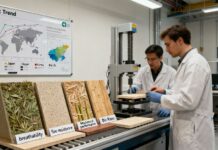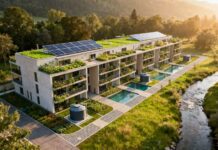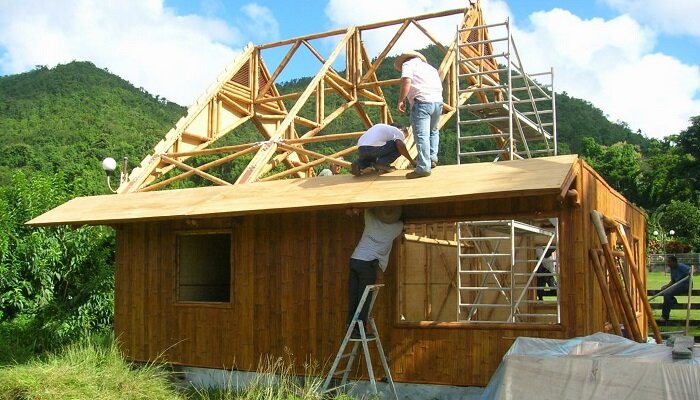Introduction
As the construction sector shifts toward renewable raw materials to curb greenhouse gas emissions, numerous alternative building materials are being studied to reduce their carbon footprint. These materials typically utilize bio-aggregates to create new sustainable construction materials while enhancing the buildings’ thermal properties. Large quantities of bio-aggregates, such as bamboo waste, wood shavings, rice husk, and hemp are employed to develop bio-based cement mixtures. These bio-concretes, derived from such mixtures, are lightweight, serve as thermal insulators, and have the potential to diminish the construction industry’s ecological impact. However, due to the high porosity of bio-aggregates, conventional design rules for ordinary cement-based structures are not suitable for bio-concrete. In this context, the study happened to involve extensive experiments so as to explore the potential of treated bamboo aggregates when it came to producing bio-concrete.
Experimental Procedures
The bamboo waste used in the study was sourced from a Brazilian company utilizing the culms as construction elements. Bamboo particles- BPs were prepared by crushing, refining, and sieving these bio-aggregates. Brazilian Portland cement was also used in BBC production. Since extractives in bio-aggregates can adversely affect cement setting and hardening, washing the aggregates in hot water can mitigate these effects. An isothermal calorimetry test was conducted to determine the optimal number of BP washing cycles for proper cement hydration. Consequently, BPs happened to be washed in hot water at 80 °C for one hour before producing BBC. After air-drying the BPs, the elongated pile method was used for homogenization. Four different BBC composites were produced by varying the cement-to-bamboo ratios to 2.5 and 3 wt.%, corresponding to 50% and 45% BP volume fractions, respectively. The water-to-cement ratio happened to be set at 0.4 and 0.5 in order to make sure of a minimum standard consistency index of 255 mm for good workability. A flow table test assessed the workability of fresh BBC, while apparent density was analyzed using six cylindrical specimens- 50 mm diameter, 100 mm height cured for 28 days. Additionally, the insulating capacity of BBCs was evaluated through a thermal conductivity test using eight specimens- 50 mm diameter, 20 mm height. Water absorption by capillarity happened to be measured over a span of 28 days on four cylindrical specimens for each of the BBC composite. A drying shrinkage test was also conducted using four prismatic samples for each bio-concrete, measuring length variation and mass loss over 90 days.
Findings and Analysis
The isothermal calorimetry test indicated that washing BPs in hot water- 80 °C effectively prevented delays in cement hydration. As a result, all prepared BBC mixtures were homogeneous in the fresh state, with their spread ranging between 268 mm and 290 mm, demonstrating good workability and ease of molding. The thermal conductivity and density of BBC specimens varied from 0.315 to 0.519 W/mK and 693 to 786 kg/m3, respectively, indicating their insulating nature and low density. These values decreased with an increasing BP content due to the high porosity of BPs. The capillary behavior of BBCs showed high absorption kinetics in the initial hours of curing, which decreased beyond ten days to a plateau. For a specific cement/bio-aggregate ratio, increasing the w/c ratio did not significantly alter this absorption behavior. However, capillary kinetics increased with higher biomass volume, correlating with the concrete’s water absorption coefficient and BP’s porous structure. The BBC composite with 45% BP and 0.4 w/c exhibited minimal shrinkage and mass loss when immersed in water. Deformation and weight variation increased with higher BP proportion and w/c ratio in the concrete mix. Thermal conductivity tests confirmed the insulating properties of bio-concrete, with values between 0.315 and 0.519 W/mK. Researchers noted that drying shrinkage and mass loss evolved in two stages: rapid retraction in the first 20 days, followed by a stable plateau with less than 3% variation. This behavior was attributed to the porosity of the cement matrix and BPs, as well as relative humidity.
Summary
Researchers concluded that the fundamental properties of BBC, including density, thermal conductivity, capillary water absorption, and drying shrinkage, were thoroughly investigated. The lightweight and insulating BBCs incorporating bamboo aggregates proved feasible for various construction applications, such as internal partitions, false ceilings, retrofitting façades, and hollow brick walls. However, greater deformation and weight variations were observed with increasing bio-aggregate content and w/c ratio. Consequently, the authors recommended further studies to improve the cementitious matrix of bio-concrete by replacing cement with pozzolanic materials. Additionally, the natural durability- against external weathering and biological robustness- against fungal attack of BBCs require thorough assessment for practical applications.






























